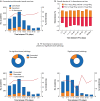Double faecal immunochemical testing in patients with symptoms suspicious of colorectal cancer
- PMID: 36785496
- PMCID: PMC10364540
- DOI: 10.1093/bjs/znad016
Double faecal immunochemical testing in patients with symptoms suspicious of colorectal cancer
Abstract
Background: Faecal immunochemical test (FIT)-directed pathways based on a single test have been implemented for symptomatic patients. However, with a single test, the sensitivity is 87 per cent at 10 µg haemoglobin (Hb) per g faeces. This aims of this study were to define the diagnostic performance of a single FIT, compared with double FIT in symptomatic populations.
Methods: Two sequential prospective patient cohorts referred with symptoms from primary care were studied. Patients in cohort 1 were sent a single FIT, and those in cohort 2 received two tests in succession before investigation. All patients were investigated, regardless of having a positive or negative test (threshold 10 µg Hb per g).
Results: In cohort 1, 2260 patients completed one FIT and investigation. The sensitivity of single FIT was 84.1 (95 per cent c.i. 73.3 to 91.8) per cent for colorectal cancer and 67.4 (61.0 to 73.4) per cent for significant bowel pathology. In cohort 2, 3426 patients completed at least one FIT, and 2637 completed both FITs and investigation. The sensitivity of double FIT was 96.6 (90.4 to 99.3) per cent for colorectal cancer and 83.0 (77.4 to 87.8) per cent for significant bowel pathology. The second FIT resulted in a 50.0 per cent reduction in cancers missed by the first FIT, and 30.0 per cent for significant bowel pathology. Correlation between faecal Hb level was only modest (rs = 0.58), and 16.8 per cent of double tests were discordant, 11.4 per cent in patients with colorectal cancer and 18.3 per cent in those with significant bowel pathology.
Conclusion: FIT in patients with high-risk symptoms twice in succession reduces missed significant colorectal pathology and has an acceptable workload impact.
© The Author(s) 2023. Published by Oxford University Press on behalf of BJS Society Ltd.
Figures





Comment in
-
Comment on: Double faecal immunochemical testing in patients with symptoms suspicious of colorectal cancer.Br J Surg. 2023 Jun 12;110(7):872. doi: 10.1093/bjs/znad122. Br J Surg. 2023. PMID: 37155367 Free PMC article. No abstract available.
References
-
- Gonzalez-Hermoso F, Perez-Palma J, Marchena-Gomez J, Lorenzo-Rocha N, Medina-Arana V. Can early diagnosis of symptomatic colorectal cancer improve the prognosis? World J Surg 2004;28:716–720 - PubMed
-
- National Institute for Health and Care Excellence; (NICE) . Suspected Cancer: Recognition and Referral. London: NICE, 2015 - PubMed

